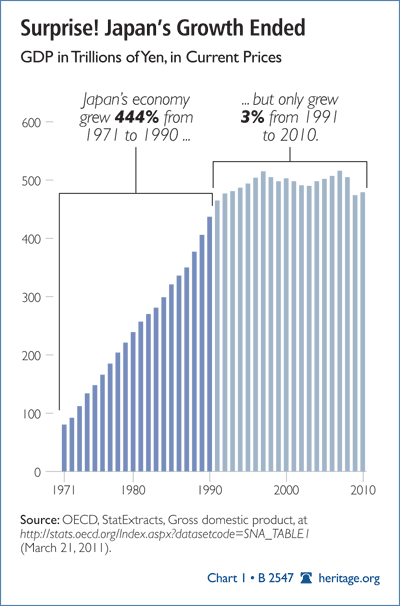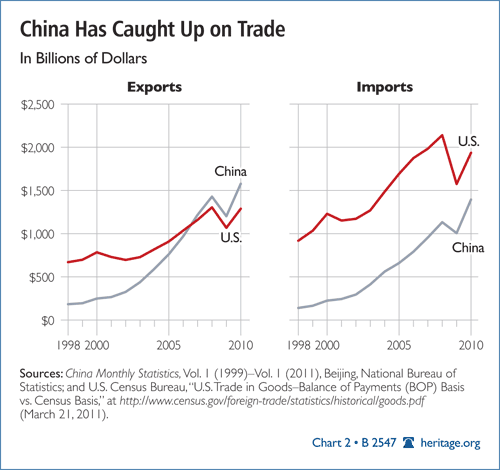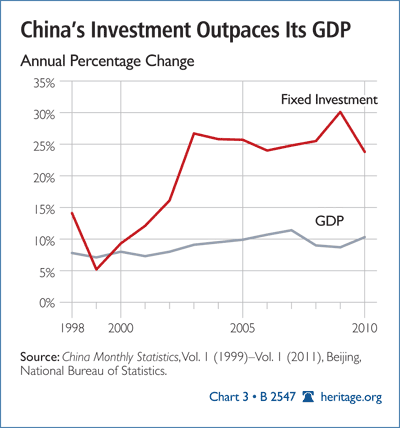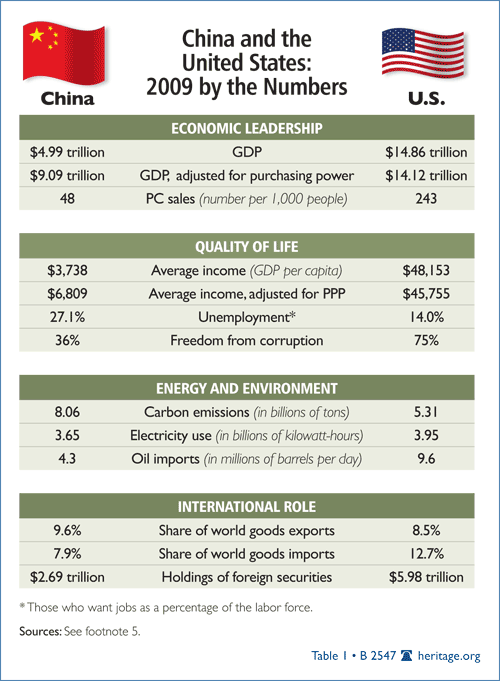Abstract: China’s leap from poverty due to the marvelously successful market reforms introduced in 1978 has obscured serious weaknesses in its economy—especially compared to the American economy. These weaknesses have been exacerbated by renewed Chinese state intervention that began around 2003. Many seem convinced that China is at the cusp of surpassing the U.S. economically. But Americans should not lose track of their huge advantages over the Chinese—in income, in natural resources, and in surprising areas such as labor. Heritage Foundation China and economic expert Derek Scissors, explains why it is vital that the U.S. remember its strengths and recognize profound Chinese weaknesses.
There is increasingly loud talk of China surpassing America in raw economic size within the next decade, or, adjusting for purchasing power, as soon as this year. Some of these claims are plainly inaccurate, most are misleading, and all are potentially harmful.
The claims contribute to false impressions about the future of the Asia–Pacific region, even the world as a whole. Perceptions of China’s economic strength and importance underpin its global presence, from its own borders to sub-Saharan Africa and Latin America. A deeper look, though, shows that the People’s Republic of China (PRC) is still far smaller and poorer than the U.S. on the most important economic dimensions, so its true global weight is correspondingly limited.
While this paper focuses on economics, all U.S. policy should be founded on good information about China’s relative position right now and what the future will hold. The U.S. has a huge economic advantage that should last for several generations, at least. The best strategy to compete with the PRC thus begins with getting the American house in order—and in doing so, the U.S. should absolutely not imitate the PRC. A battle with Beijing over which government can intervene in its economy more is doomed to failure and comes with ugly drawbacks that have been lost in China hype.
America can and should win the economic competition. However, it should not hope for China’s failure. An economically weakening or stagnant China hurts the rest of the world. In contrast, a China on a more sustainable course benefits everyone, including the U.S.
America vs. China: Today
One of the most surprising developments resulting from the financial crisis is the belief among ordinary Americans that China has become the world’s leading economy. This view appeared in the roughest times of 2009 and has persisted even though the impact of the crisis has begun to ebb. U.S. media have frequently conveyed the same belief.[1] But it is patently absurd.
The principal reason for Americans’ dismay is jobs: Official U.S. unemployment breached 9 percent during the past two years. It is even higher when counting those who have stopped looking for jobs, yet would work if they could. In contrast, Beijing issues an urban unemployment figure below 4.5 percent, but this includes only those officially recognized and no one, including officials at the Ministry of Human Resources and Social Security, believes it is accurate.[2]
The state-controlled Chinese Academy of Social Sciences placed urban unemployment at 9.4 percent before the full impact of the financial crisis was felt. The PRC’s rural unemployment has long exceeded 20 percent.[3] True Chinese unemployment is certainly higher than true American unemployment, and, depending on how unemployment is measured, could be much higher.
The contest in income, meanwhile, is utterly unequal. American Gross Deomestic Product (GDP) in 2009 was nearly $15 trillion, while China’s was $5 trillion, despite a population more than four times as large. The average American had $48,000 in 2009 income, the average Chinese had less than $4,000. Both of these gaps narrowed in 2010, as they have almost every year in the past 30, but they remained huge.
It is true that many consumer goods are cheaper in China, some much cheaper. Economists try to formalize different prices in different countries by checking the purchasing power of the same amount of money. The idea is that the same amount of money should buy the same good or service everywhere. When it does not, because one country has far lower prices than another, for instance, it can be useful to compare incomes using differences in prices. The difference in prices is called purchasing power parity (PPP). PPP recognizes that earning $50,000 a year in London is very different from earning $50,000 a year in Luanda, Angola. But PPP is often not very accurate.
PPP is one of the reasons for the claims that China is about to pass the U.S. Adjusting for purchasing power, the CIA estimates China’s GDP to be near $10 trillion in 2010.[4] PPP estimates are imprecise and some figures for China are still higher. Because China is growing quickly, the $5 trillion gap PPP shows between the U.S. and China could, if American growth stagnates, disappear in as little as five years.
While PPP is a step in the right direction in principle, there are multiple pitfalls. For economies as large and diverse as those of America and China, differences in purchasing power within each country are huge. It is almost meaningless to find an average price for all of the U.S. or all of China. Perhaps even more important in comparing two economies, PPP changes over time. Because prices change at different rates in different places, purchasing power comparisons made at one point can be quite misleading just a few years later, and even more misleading when projected forward in time.
The PRC offers a dramatic example. Chinese inflation has generally been growing faster than American inflation since about 1999. Due to the cumulative effect, the World Bank retroactively cut the size of its 2005 PPP estimate of China’s GDP by more than 40 percent.[6] In an instant, the Chinese economy became 40 percent smaller. If this had not happened, Chinese GDP would be comparable to American GDP right now. Moreover, since 2005, Chinese inflation has again been faster than American inflation. The World Bank has not yet adjusted for this faster inflation. Nearly all economic projections that show China surpassing the U.S. in the next few years are based on a PPP measurement that is out of date. These projections overstate Chinese GDP considerably and should not be trusted.[7]
If China’s economy is well behind that of the U.S. now, how long will that last? While official Chinese data are certainly flawed, it is also certain that Chinese growth has outpaced American growth by a huge margin over the past 30 years.[8] Between 1981 and 2010, U.S. GDP increased a fairly impressive 4.7 times.[9]Chinese figures are less precise but it looks as if China’s GDP increased approximately 30 times over the same time period. Such an outstanding performance appears to all but guarantee that China will surpass the U.S. in the next 30 years, and probably far sooner. In fact, the PRC’s outstanding performance has led to some exceptionally inaccurate projections of its trajectory for the next three decades and beyond.
Whither Chinese Growth?
Economic results are not determined by history. If they were, Chinese reform would have failed and the pre-1978 suffering would have continued. If they were, the U.S. would remain the world’s largest economy simply because it has been so for more than a century. If 30 years of rapid growth guaranteed 30 more, Japan would now be the world’s largest economy. Instead, 40 years of Japan soaring up the global ladder have been followed by 20 years of stagnation.
Results are instead determined by a nation’s resources and policies. Resources include but are not confined to natural resources; there are also critical human and financial resources. Beijing in particular has relentlessly pushed investment forward for a decade. In 2001, fixed investment was the equivalent of 38 percent of GDP. In 2010, because its growth easily outpaced GDP every year since 2001, fixed investment was the equivalent of 70 percent of GDP.[10] It is not possible to exceed 100 percent of GDP. The policy of boosting growth simply through the pure quantity of money spent cannot extend through the current decade as it did through the last decade—China must change course or face sharply smaller GDP gains.
In terms of natural resources, the PRC’s environmental difficulties are widely known, as is its stark dependence on commodities imports.[11] China is the world’s second-largest oil importer, the biggest coal importer, the biggest soybean importer, and accounts for two-thirds of global iron ore trade by itself. The same kind of results hold for many metals, and corn could be next.
Food grain dependence stems from land depletion. More than one-fourth of China’s land can be classified as desert, and nearly half suffers from sand erosion. Related, and perhaps even worse, China is exceptionally poorly endowed with water, needed for farming and industrial activity.[12] Greater agricultural productivity drove Chinese growth and helped balance income in the 1980s, but natural resources have long since become a major obstacle to growth rather than a spur.
The Communist Party has deftly used a generation’s worth of fast expansion in the workforce to help create rapid GDP growth. The period of demographic expansion will end over the coming decade, though, and be followed by an exceptionally sharp period of contraction, due in part to China’s one-child policy. Beginning in about the middle of the decade, the ensuing two generations will be as much as one-fifth smaller than the one before.
By 2035, close to 20 percent of the population will be age 65 or older. The analogous figure for Japan in 2008 was just over 20 percent age 65 or older. Starting in approximately 2015 and over the course of two decades, the pure quantity of labor will shift from contributing nearly 2 percentage points to GDP growth to subtracting around 1 percentage point.[13]
Limits on investment, depleted physical resources, and a coming plunge in the amount of available labor leave more efficiency in use of labor and capital as the drivers of future growth. Government bureaucrats may guess correctly, but inevitably make serious mistakes. Only competitive markets promote enduring efficiency gains. In the early 1990s, Japan faced a similar situation—resource weakness, declining return to capital, and a shrinking labor force. Tokyo repeatedly chose fiscal stimulus over reform. The outcome has been unpleasant.

After more than two decades of steady market reform, China intensified its state-directed stimulus in 2002 and again in 2008. The workforce has not yet begun to shrink and a mixed economy can sustain low-return investment for much longer than a market economy. Within a decade, however, the Communist Party must grit its teeth and return to a market path or suffer Japan’s fate. If political will is lacking, China’s growth story will vanish as Japan’s did, and the many projections of Chinese predominance will prove as illusory as they were for Japan 20 years ago.
The obvious questions are if and when the PRC will restart reform. Here, China-watching is still guesswork. It is certain that the longer Beijing waits, the more painful a return to the market will be. The economy is now distorted by investment similar to how the U.S. economy is distorted by deficit spending. As with American budget warnings since 2007, China’s State Council first cited investment dependence as a problem in 2004, and it has become far worse since.[14]
Sharp policy changes are more feasible in the PRC than in most countries due to centralized decision making. Still, an abrupt end to state subsidization of investment would cause several years of slow growth or even contraction, whether or not the party acknowledged it. A gradual change of direction is much more likely, but would extend the period of economic inefficiency and environmental destruction. Such an extension could cost China dearly as the labor situation deteriorates by the end of this decade.
So, Whose Century Is It?
Comparing the U.S. and China, the next World Bank inflation adjustment will drop China further behind (and bring the PPP comparison closer to the simple GDP comparison). America’s growth rate is obviously another major variable. Nonetheless, its raw population means that the PRC will likely pass the U.S. at some point after a resumption of market reform.
For example, if the 2012 Communist Party Congress were to nullify actions by the 2002 Party Congress and restore Deng Xiaoping’s economic model, this would enable roughly two more decades of rapid growth, perhaps in the 7 percent to 8 percent range, then gently decreasing to the 5 percent to 6 percent range over time. China would then surpass the U.S. in PPP-adjusted size before 2025 and pass the U.S. in simple GDP three or four years after that. Delaying reform or other missteps will postpone the dates. Finally, the somewhat bizarre example of Japan appears to indicate that China could also decline to reform, suffer long-term stagnation, and never pass the U.S. at all.
Raw size of the economy, though, is far from the whole story. At the time of GDP convergence, the average American’s income will still be more than four times greater than that of the average Chinese. Despite polls describing China as the economic leader, no one in the U.S. would trade the number-one ranking in GDP for a 75 percent cut in salary. If it quickly returns to the reform path, the PRC will be bigger than the U.S. in less than a generation, but America will remain much richer, indefinitely.
What about other measurements? Economic leadership cannot be separated from technology. There are many technology indicators, and they change over time. At the moment, personal computers to some extent represent both productivity of citizens through technology and the setting for fresh innovation. The results mimic GDP: Annual Chinese sales will shortly pass American sales, but on a per capita basis, the U.S. is far ahead. This suggests that the PRC as a nation will be increasingly capable while individual Americans will remain more productive.
Productivity is reflected by employment, where the numbers may surprise those who see the PRC as the global leader. It is generally accepted that Chinese policy is driven first by the need to create jobs, but the magnitude of that challenge is not widely understood. When unemployment is measured by those who want jobs and do not have them, China’s unemployment is double that of the U.S. even in a very weak American year. This is a staggering burden for China.

The PRC’s claim to leadership is stronger in other areas. China’s mountain of foreign exchange reserves is frequently cited as proof of its power. The official tally was $2.85 trillion at the end of 2010 and is still soaring.[15] Two important facts about reserves are usually missed, though. The first is that, for technical reasons, they cannot be spent toward pressing needs inside China and must be held overseas.[16] Even that suggests great Chinese financial clout around the world. The second fact is that American investment around the world is far larger. At the end of 2009, the latest figure available, U.S. portfolio investment overseas was almost $6 trillion. U.S. direct investment overseas exceeded $3.5 trillion.[17] Even when including Chinese investment beyond official reserves, total American investment is roughly three times larger than total Chinese investment.[18]
China is the world’s largest exporter and likely to become the world’s top trader in 2012. Its impact on global demand for many goods will rival and often exceed that of the U.S. There is the standard drawback associated with trade, of course: China is more dependent than America on foreign markets and supplies. Raw exports are roughly three times more important in Chinese GDP than in American GDP. The PRC’s energy dependence is comparable to America’s but China is far more reliant on foreign grain and metals than is the U.S. China’s bid for leadership in trade is evident, but comes with a price that is also increasingly evident.
Competing and Winning
China’s economy has obviously been catching up with America’s and is likely to grab the lead in important economic and trade measures soon, even while continuing to lag well behind in others. America has never faced this kind of economic test. For more than 60 years the U.S. was simply unchallenged; for 160 years before that, the U.S. was rising up the global economic ladder.
Nonetheless, America retains multiple, critical advantages over China. As noted, economic results stem from policy choices and possession of various kinds of resources. In natural resources, the U.S. has a clear edge. Depending on the measurement used, the U.S. may have twice as much water as the PRC. The U.S. has more arable land than China, with less than one-fourth the population to support.[19] The U.S. has larger coal reserves, while relying on coal less.[20] Pollution of nearly all kinds is far less of a problem in the U.S, indicating that the value of physical resources will remain higher well into the future.[21]
The resource comparison has immediate implications for the other half of economic success—policy. Around the world and throughout history, greater individual property rights have been shown to enhance both the short-term and long-term value of resources. This was seen in spectacular fashion in 1980s China, when a modicum of property rights for farmers caused an explosion in agricultural productivity and rural income.[22] Unfortunately, the past few years have seen the PRC re-embrace “state” ownership, which diffuses responsibility and undermines sustainability. Subsidies make matters worse, encouraging unsustainable development patterns.[23]
For labor, a simple indication of American advantage is the ratio of GDP to worker—the U.S. has a larger economy despite a smaller labor force. The American lead is on the order of 11:1; the average American worker is 11 times more productive. Manufacturing, where China is thought to be the new global leader, requires more than eight Chinese workers to equal the production of one American worker.[24] While productivity has been rising in the PRC, the demographic shift means its labor force will shrink. Over the next generation, China will transform from a society younger than America’s to a society that is older than America’s, with proportionately fewer workers.
Greater productivity makes the average American much more prosperous than the average Chinese. Nor has this prosperity come at the expense of jobs; more of the labor force is employed in the U.S. than in the PRC. Good policy thus embraces effective education and training and a youthful labor force. There is also a financial component to labor force changes: Unfunded pension liabilities must eventually be addressed. As vast as these are in the United States, they are smaller for the U.S. in relation to GDP than for China.[25]

As for capital, both countries are currently poor performers. Just a few years ago, the U.S. sustained 2 percent to 3 percent GDP growth without extracting $1.5 trillion to fund federal deficits. Until 2003, Chinese fixed investment rose roughly as quickly as GDP; since 2003, it has risen more than twice as fast. The two countries’ return on combined public and private investment is falling as more financial resources run through the state and are applied to commercially wasteful projects, repeating the mistake made and continued in Japan. Also mimicking Japan, American real interest rates were below 2 percent in 2010 while Chinese real rates were negative. Dangerously low American and Chinese rates are linked by a set of poor policies in both countries that extend beyond simple interest rate targets and have created excess liquidity worldwide.
As the Index of Economic Freedom has demonstrated both across time and across counties, whichever nation can rein in public finance the quickest will have an edge in contributing to economic growth.[26] Whether it is American government borrowing or the many Chinese policies that exalt the place of investment within the economy, overreach will eventually be corrected, voluntarily or involuntarily.
In the meantime, the desire among some American politicians to imitate Chinese subsidies must be blocked. Chinese subsidies go almost exclusively to state entities tightly bound to the party institutionally and personally. Subsidies have widened income disparities after these were dampened in the first decade of reform (when subsidies were slashed). While subsidies appear to increase growth, they are ultimately unsustainable and apparent gains are illusory. Government is not organized to create wealth and subsidies encourage development of a less efficient economy.
What the U.S. Should Do
To compete successfully with China, the U.S. should:
- Limit federal control of lands to defense needs and preservation of natural and cultural phenomena. The Department of the Interior should avoid resource management, shown to distort the economy and reduce prosperity;
- Immediately and sharply cut the federal deficit. Congress must ignore claims that deficit spending somehow creates wealth, as it actually forces the nation’s capital toward low returns;
- In particular, reduce subsidies of every kind. At this point, energy subsidies are especially damaging; and
- Ensure a well-educated and growing labor force. The Departments of Education and Justice should stress immigration transparency and education diversity, where the U.S. has an edge over China.
To encourage mutually beneficial Chinese development, the U.S. should:
- Focus on subsidies as the biggest Chinese trade distortion. The Department of the Treasury, the United States Trade Representative, and Department of Commerce should estimate Chinese subsidies for the purposes of reducing them through bilateral and multilateral negotiations; and
- As part of these negotiations, should offer to welcome Chinese investment in natural resources in exchange for greater American access to the PRC market.
The U.S. Holds the Cards
The PRC’s rise from poverty due to the marvelously successful market reforms introduced in 1978 has obscured serious economic weaknesses compared to the U.S. These weaknesses have been exacerbated in important ways by renewed Chinese state intervention starting around 2003. America should not lose track of its advantages over China—in wealth but also in natural resources, and in surprising areas such as employment. Most important, the U.S. should not make the error of mimicking unwise Chinese policies, and should instead focus on getting the American house in order.
—Derek Scissors, Ph.D., is Research Fellow in Asia Economic Policy in the Asian Studies Center at The Heritage Foundation.
